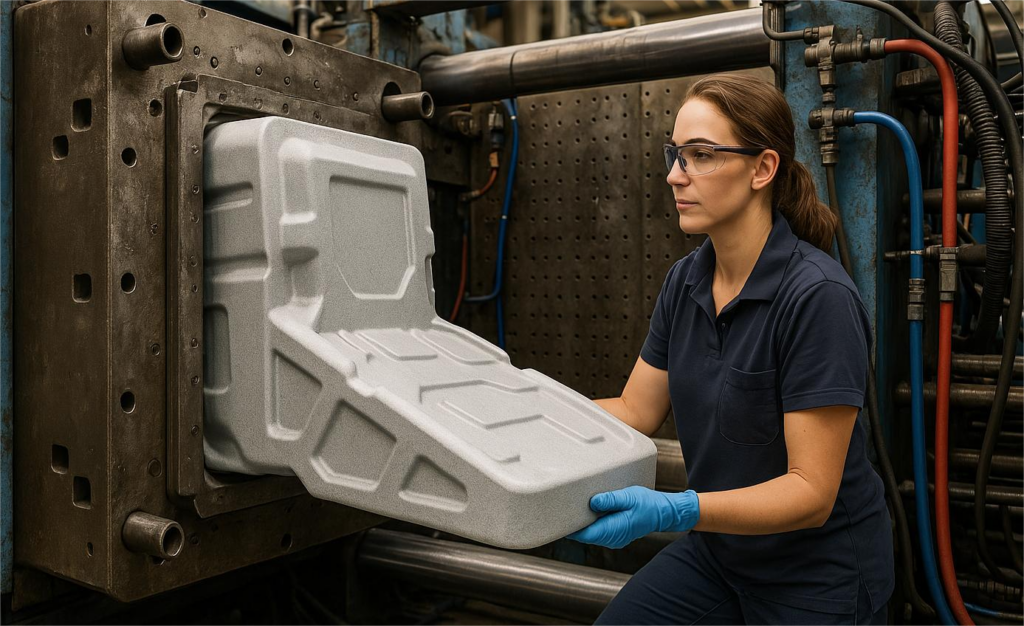Big Parts, Big Problems? Not Necessarily.
Manufacturing large parts is… well, a headache. They’re heavy, they warp, they eat up materials like it’s a buffet, and don’t even get started on the tooling costs. You’d think we’d have nailed a better method by now, right?
Turns out, we kind of have.
It’s called structural foam molding, and while it might not sound glamorous, it’s quietly changing the game for large-scale manufacturing. We’re talking about a process that builds tough, lightweight parts with fewer defects, lower costs, and a whole lot less drama. So yeah—big parts, meet your match.
Wait, What Is Structural Foam Molding?
Let me explain. Think of structural foam molding as the laid-back cousin of traditional injection molding. It uses a mix of thermoplastics and gas (usually nitrogen) to create parts with a solid outer skin and a foamed core. That means it’s molded under lower pressure but still delivers strength and structure.
Imagine making a loaf of bread where the crust is firm and golden, but the inside’s full of airy goodness. That’s kind of what’s going on here, except instead of sourdough, we’re working with polymers.
This lower-pressure process opens up a range of possibilities that standard injection molding struggles with, especially when it comes to size and cost.
Strong Enough to Take a Beating. Light Enough to Carry.
Here’s where structural foam really shines. Because of its unique composition—a tough skin with a foamed core—it has an exceptional strength-to-weight ratio.
In industries where every pound counts, like automotive or logistics, that balance is priceless. You get sturdy, impact-resistant parts that don’t weigh down your entire assembly or require a forklift just to move. Literally.
And that foamed core? It doesn’t just lighten the load. It helps absorb impact without cracking under pressure, which means your parts last longer and hold up better over time.
Big Parts? Bring ‘Em On.
You know what usually happens when you try molding large parts? Warping. Sink marks. Inconsistencies. Basically, a lot of yelling on the factory floor.
But structural foam is made for going big.
Because of the low-pressure process and uniform material flow, it handles large, thick-walled parts like a pro. Think industrial pallets, utility carts, storage enclosures, and even playground equipment. The kind of stuff that traditional injection molding sweats over.
Here’s the kicker. It can even reduce the number of parts in your assembly by combining what would’ve been three or four components into one solid mold. That means fewer welds, fewer screws, and fewer headaches.
Lower Pressure, Lower Costs, Fewer Mold Meltdowns
Traditional high-pressure molding is tough on molds. Over time, it grinds them down, warps them, and sends your maintenance team scrambling.
Structural foam molding, though, runs at lower pressures. Your molds last longer, and you’re not shelling out every few years to replace them. Tooling costs are considerably lower. Maintenance is way less frequent. It’s kind of like driving a car that just doesn’t break down.
That adds up fast, especially for high-volume operations where even small savings per part can stack into serious margins.
Better Looks Than You’d Expect
There’s a misconception floating around that foamed parts look… rough. Like DIY garden furniture rough. But honestly, that’s outdated.
Modern structural foam molding can produce surfaces that are smooth, consistent, and surprisingly polished. Textured finishes? Easy. Painted or coated after? No problem.
Let’s face it. Function matters, but aesthetics sell. Whether it’s a visible housing for machinery or branded casing for equipment, looking the part still counts.
Freedom to Design Like You Mean It
Here’s the thing. When you’re boxed in by tooling limitations, you end up compromising on design. Maybe you thin out walls to make the mold work. Or simplify geometries because your process can’t handle complexity.
Structural foam gives you more wiggle room. It allows for thicker walls, variable cross-sections, and even integrates ribs or structural supports without making the mold cry. Engineers get to stretch their legs creatively, which often leads to smarter designs and better performance.
And let’s be real—nobody likes assembling a puzzle with half the pieces missing just to fit a spec sheet.
Less Plastic. Less Waste. More Sense.
Now, we’re not going to wave a giant green flag here, but there’s something to be said about using less material and getting more durability out of it.
Structural foam uses less resin overall. And because the parts are tougher and more damage-resistant, you’re not churning out replacements every quarter. That’s fewer raw materials, less landfill waste, and a longer lifecycle.
Sustainability isn’t the headline here, but it’s definitely in the fine print. And honestly, that’s where the good stuff usually lives anyway.
So, What’s the Catch?
Here’s the funny part. There really isn’t one.
Sure, structural foam molding won’t be right for every product. You’re probably not going to use it for tiny precision parts or high-gloss consumer goods. But for medium to large components where strength, cost, and durability matter? It’s hard to beat.
You get big, rugged parts without big, rugged problems.
Maybe it’s time more manufacturers took a second look at this workhorse of a process. If you’re exploring custom solutions or looking for a partner who specializes in structural foam molding, working with an experienced plastic manufacturer can make all the difference. When it comes to large-scale production, this method isn’t just a solid option — it’s a smart one.
And honestly? It’s about time we made big parts feel like less of a big deal.



